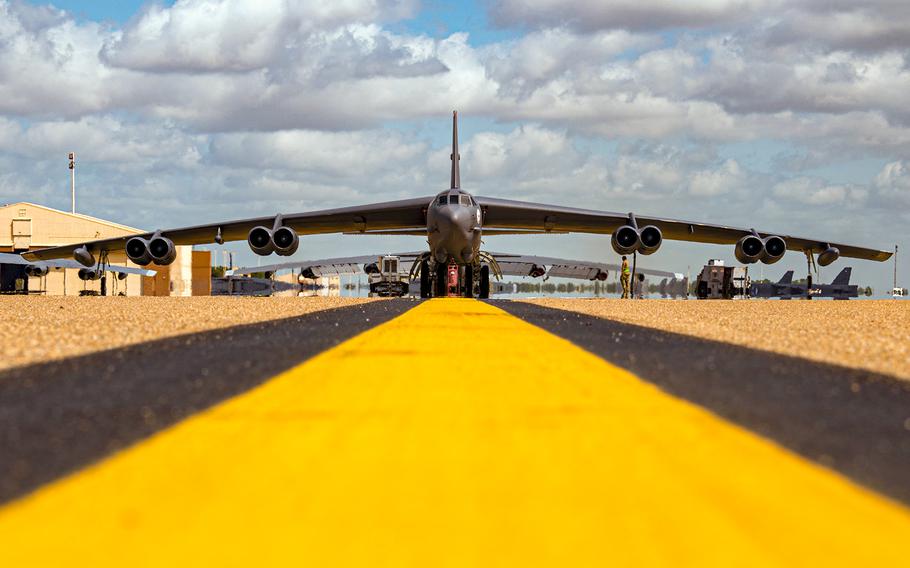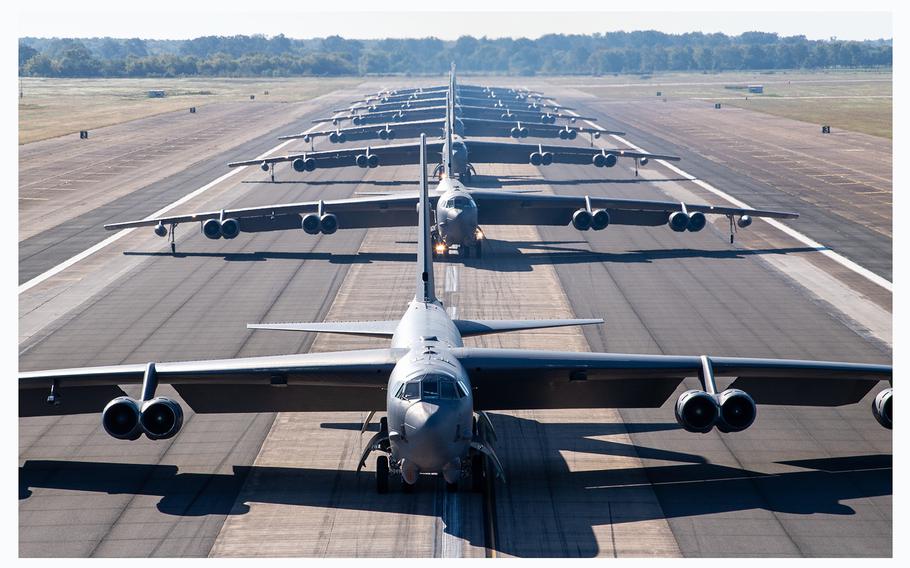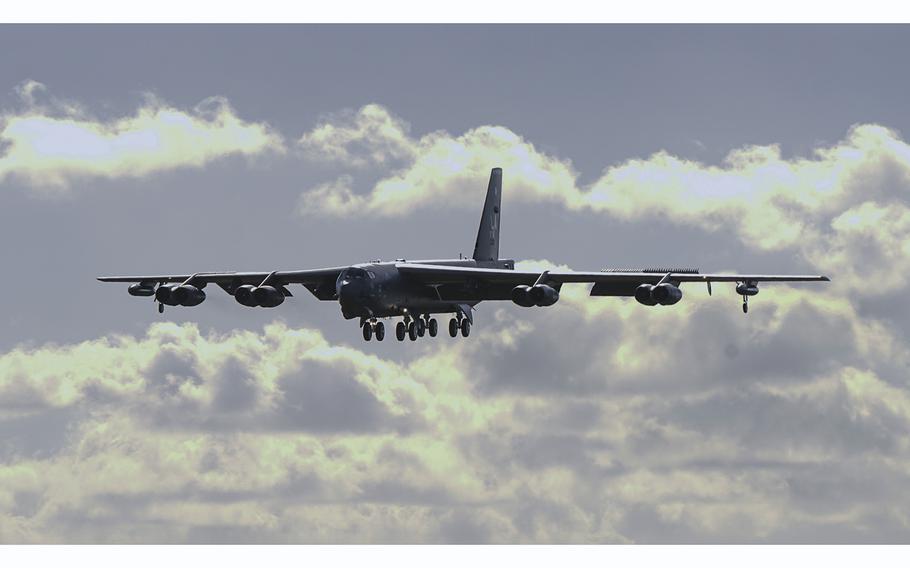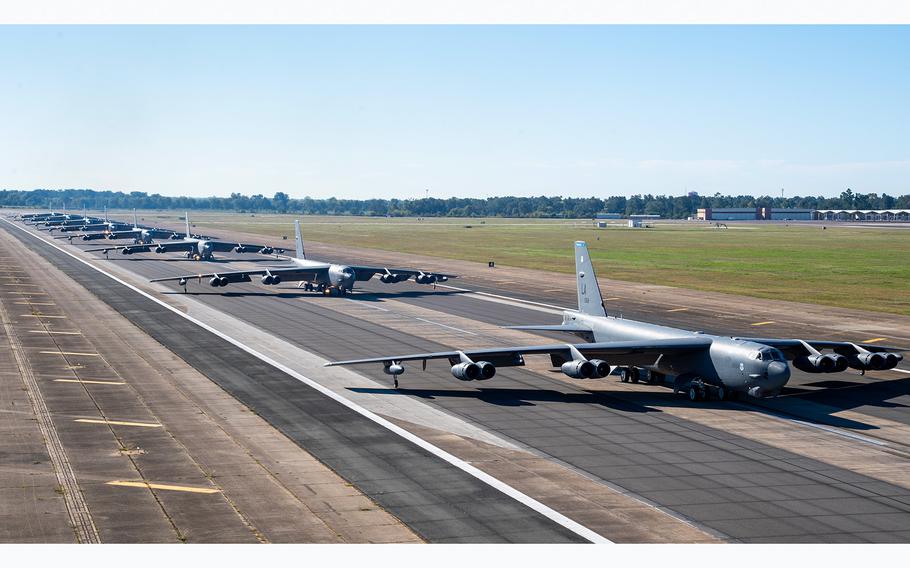
An Air Force B-52H Stratofortress bomber assigned to the 307th Bomb Wing goes through an engine check on June 24, 2021, at Barksdale Air Force Base, Louisiana. (Kate Bragg/U.S. Air Force)
The Air Force risks undermining its $48.6 billion B-52 Stratofortress modernization plan by failing to track what spare parts are available for the aged bomber and where they continue to be manufactured.
“Despite its age, the B-52 remains a cornerstone in the Air Force’s arsenal,” Air Force Inspector General Robert P. Storch wrote in an audit released Nov. 28. “The supply chain challenges identified in this audit could impact the Air Force’s ability to keep the aircraft flying.”
The Air Force operates 76 B-52H bombers, the last built in 1962. They are the last of 744 B-52s built by Boeing for the Air Force, the first to enter service with the Air Force in 1955.
A $48.6 billion Pentagon plan calls for the B-52 to receive upgrades to extend its service life until 2060. The bombers would get new Rolls Royce F130 engines, upgraded avionics, radar, and an enlarged and modernized weapons bay. After the transition, the bombers would change their designation to signify a new variant, B-52J.

B-52H Stratofortresses from the 2nd Bomb Wing line up on the runway as part of a readiness exercise at Barksdale Air Force Base, La., on Oct. 14, 2020. (Tessa Corrick/U.S. Air Force)
The Air Force has maintained the bombers, saying they remain a versatile weapon with the existing B-1B, B-2, and future B-21 bomber force.
Though the upgrades will allow the B-52 bombers to operate as a 21st-century aircraft, the airframe and most parts remain from the original 1960s manufacturing.
The “Audit of B-52 Diminishing Manufacturing Sources and Material Shortages” found the Air Force did not have a comprehensive list of spare parts required to keep the B-52 in service and relied too heavily on cannibalizing parts from existing B-52s.
The audit found the Air Force needed to keep up with the number of companies ending production of parts that no longer exist for the B-52.

An Air Force B-52 Stratofortress bomber lands at Andersen Air Force Base, Guam, on Jan. 16, 2018. (Richard Ebensberger/U.S. Air Force)
Because of the shortcomings, the audit said the Air Force relied too often on cannibalizing parts from existing aircraft, which led to fewer mission-ready aircraft. Waiting for parts has also diminished the number of aircraft that are mission-ready.
The audit said the Air Force agreed with its recommendation to complete an annual Weapon System Support Program coding review to ensure the proper codes for spare parts are in the inventory system. The program would be worked out with the Defense Logistics Agency.
The audit said the Air Force had only partially responded to two other recommendations, so their status remains open for audit and review.
Those recommendations include compiling a complete list of spare parts of the B-52 and a signed document creating a system to identify and track manufacturers making components and monitor their ongoing plans to continue or terminate making parts.

B-52H Stratofortresses from the 2nd Bomb Wing line up on the runway as part of a readiness exercise at Barksdale Air Force Base, La., on Oct. 14, 2020. (Tessa Corrick/U.S. Air Force)
The B-52H is flown by two active duty and one reserve bomb wing.
The 2nd Bomb Wing at Barksdale Air Force Base in Louisiana and the 5th Bomb Wing at Minot Air Force Base in North Dakota operate 58 B-52s for the active-duty Air Force. The 307th Bomb Wing of the Air Force Reserve at Barksdale AFB operates 18 B-52s.
About 12 additional B-52 are in storage at Davis-Monthan Air Force Base Air Force Base near Tucson, Arizona.